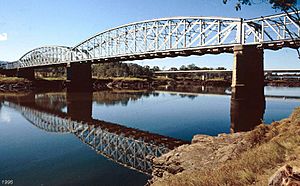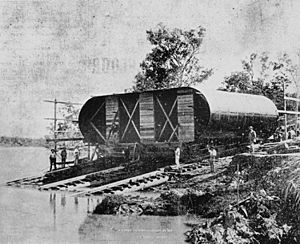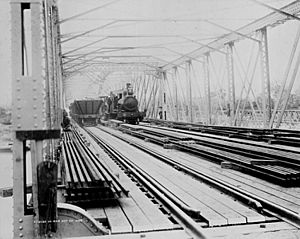Alexandra Railway Bridge facts for kids
Quick facts for kids Alexandra Railway Bridge |
|
|---|---|

Alexandra Railway Bridge, 1996
|
|
| Location | Adjacent to North Street, Rockhampton, Rockhampton Region, Queensland, Australia |
| Design period | 1870s - 1890s (late 19th century) |
| Built | 1898–1899 |
| Architect | Henry Charles Stanley |
| Official name: Alexandra Railway Bridge | |
| Type | state heritage (built) |
| Designated | 21 October 1992 |
| Reference no. | 600799 |
| Significant period | 1890s (fabric) |
| Significant components | pier/s (bridge), abutments - railway bridge, plaque |
| Builders | George Charles Willcocks |
| Lua error in Module:Location_map at line 420: attempt to index field 'wikibase' (a nil value). | |
The Alexandra Railway Bridge is a special railway bridge located next to North Street in Rockhampton, Queensland, Australia. It was designed by Henry Charles Stanley and built between 1898 and 1899 by George Charles Willcocks. This important bridge was added to the Queensland Heritage Register on 21 October 1992, meaning it's protected for its historical value.
Contents
The Story of the Alexandra Railway Bridge
The Alexandra Railway Bridge was built from 1898 to 1899. It crosses the Fitzroy River and was a key part of the original Rockhampton Junction railway line. This bridge played a big role in developing Queensland's railway system.
Why Rockhampton Needed Railways
Rockhampton became an important town after a gold rush in 1858. It grew into a major port for central Queensland. In 1863, the Queensland government decided to use a narrow gauge for its railways. This was because narrow gauge tracks were cheaper to build.
The first railway line in Queensland opened in 1865. People in Rockhampton wanted their own railway to connect to the inland areas. The first section of line near Rockhampton opened in 1867. This line eventually reached Longreach by 1892. For a long time, Rockhampton's railway system was separate from the southern Queensland railways.
Connecting Rockhampton's Railways
By the 1880s, Rockhampton was growing fast, partly because of the gold found at Mount Morgan. The city had two separate railway lines: one going west from Stanley Street and another from North Rockhampton to Emu Park. These lines were separated by the Fitzroy River.
In 1890, engineers started looking into how to connect these two lines. The biggest challenges were building a bridge over the Fitzroy River and buying land for the connection.
Building the Bridge
The idea to build a deepwater port at Broadmount in 1894 made connecting the railways even more important. The plan was to link the western railway with North Rockhampton using a bridge over the Fitzroy River.
Initially, a single track bridge was planned. However, the Rockhampton City Council and local businesses pushed for a double line. They believed that more trains carrying livestock and goods would need the extra capacity. In 1895, the construction of the Rockhampton Junction Railway was approved. This new bridge and connecting line were the first double lines outside the main Brisbane area.
George Charles Willcocks won the contract to build the railway and the Alexandra Railway Bridge in 1897. The bridge itself cost about £43,471. Construction started in 1898, after delays due to flooding.
How the Bridge Was Built
The bridge was designed by chief engineer Henry Charles Stanley. It uses five metal truss sections. Two of these sections are 75 meters (246 feet) long, and two are 30.5 meters (100 feet) long. No temporary supports were used during construction to avoid problems with floods. The large sections were floated into place using a special boat, similar to how the Albert Bridge in Brisbane was built.
When it was built, the 75-meter span was the fourth largest in Australia. The Rockhampton Junction Railway officially opened on 6 November 1899. At the opening ceremony, the bridge was named "Alexandra" after Alexandra, Princess of Wales. This bridge finally connected Rockhampton's two railway systems.
Changes Over the Years
Over time, the Alexandra Railway Bridge has had some changes:
- Weight Limits: Since 1922, heavier trains have had speed and weight limits when crossing the bridge.
- Lighting: In 1930, electric lights were added to the pedestrian walkway.
- World War II: During the Second World War in 1942, a temporary roadway was built on the bridge. This allowed American military convoys to cross the Fitzroy River when the main road bridge was unsafe. Guards managed traffic, as up to forty trains used the bridge daily. The roadway was removed in 1945.
- Power Cables: In 1948, the bridge was used to carry electric cables to supply power to Rockhampton.
- Single Line: In 1975, one set of rails was removed, making it a single-line bridge.
- Upgrades: In 1992, parts of the bridge were strengthened to handle newer, heavier trains. In 1996, the timber pedestrian walkway was replaced with a non-slip surface.
People have suggested building a new railway bridge in Rockhampton to avoid delays caused by speed limits on the Alexandra Bridge.
What the Bridge Looks Like
The Alexandra Railway Bridge crosses the Fitzroy River. It used to have two railway lines, but now it has a single line in the middle.
The bridge has five main sections, called truss spans. These are supported by two concrete ends (abutments) and four concrete piers (columns) in the river. The piers are wide and have decorative details.
The ends of the bridge have riveted 8-panel Pratt trusses. The middle of the bridge has two larger, riveted 16-panel hogback double intersection Pratt trusses. These are built on wrought iron foundations.
There is a pedestrian walkway along the southeastern side of the bridge. It has a metal handrail and a decorative balustrade. A metal plaque on the bridge tells about its opening and the people involved in its construction.
Why the Bridge is Important
The Alexandra Railway Bridge is listed on the Queensland Heritage Register for several reasons:
- History: It has been a major crossing of the Fitzroy River since 1899. It shows how the railway network developed in central Queensland and Rockhampton. It was also very important during the Second World War for military transport.
- Unique Design: The bridge features special riveted Pratt trusses that were the first of their kind in Queensland. Its main span is the second largest of its type in Queensland.
- Engineering Achievement: It shows a high level of engineering skill from its time.
- Beauty: The bridge adds to the beauty of Rockhampton's landscape and the Fitzroy River.
- Connection to Key People: It is a great example of the design work of Chief Engineer HC Stanley, who made important contributions to Queensland's railways in the late 1800s.
See Also
- List of bridges in Queensland
- List of heritage-listed bridges in Queensland
Images for kids










